It looks like you're using an Ad Blocker.
Please white-list or disable AboveTopSecret.com in your ad-blocking tool.
Thank you.
Some features of ATS will be disabled while you continue to use an ad-blocker.
share:
Some side stuff that I didn't get around to posting and not sure where it'd go, but things I came across while looking around.
The Society of Saint Pius X which has been alleged of various abuses, got excommunicated from the Church and various members from it went and formed the Priestly Faternity of Saint Peter.
Now there's a really important book inspired by Faust by the author Klaus Mann (which later became a movie in 1981), is Mephisto.
So in this concept, the main character sells his soul to the Nazis in order to get ahead in life and gain fame.
So the point of this is, that you don't even have to directly be aware that you are making a pact with dark forces for something that will not turn out to be what you'd hoped for.
How often does that seem to happen around us? How many big corporate heads, movie and music stars, politicians, etc, succumb and end up sacrificing their ethical and spiritual values in order to achieve success in their careers?? It's so commonplace of a theme that it's become it's own archetype and is ever-present throughout literature, music, art, games, etc. It's one of the most common plot concepts and is ubiquitous.
The film version of Mephisto got an Academy Award even...
Might be worth checking out actually. I haven't seen it yet but it does look good.
The Society of Saint Pius X which has been alleged of various abuses, got excommunicated from the Church and various members from it went and formed the Priestly Faternity of Saint Peter.
Now there's a really important book inspired by Faust by the author Klaus Mann (which later became a movie in 1981), is Mephisto.
The novel adapts the Mephistopheles/Dr Faustus theme by having the main character Hendrik Höfgen abandon his conscience and continue to act and ingratiate himself with the Nazi Party to keep and improve his job and social position.
So in this concept, the main character sells his soul to the Nazis in order to get ahead in life and gain fame.
The novel portrays actor Hendrik Höfgen's rise from the Hamburger Künstlertheater (Hamburg Artists' Theater) in 1926 to nationwide fame in 1936. Initially, Höfgen flees to Paris on receiving news of the Nazis' rise to power because of his communist past (learning from a friend that he is on a blacklist). A former co-actress from Hamburg, Angelika Siebert, travels to Berlin to convince Lotte von Lindenthal, the girlfriend (and later wife) of a Luftwaffe general to have him pardoned. On returning to Berlin he quickly manages to win over Lotte and her general and with his support has a wonderful career. On obtaining the role of Mephisto in Faust Part One he realizes that he actually made a pact with evil (i.e. Nazism) and lost his humane values (even denouncing his mistress as "Black Venus"). There are situations where Höfgen tries to help his friends or tell the prime minister about concentration camp hardships, but he is always concerned not to lose his Nazi patrons.
So the point of this is, that you don't even have to directly be aware that you are making a pact with dark forces for something that will not turn out to be what you'd hoped for.
How often does that seem to happen around us? How many big corporate heads, movie and music stars, politicians, etc, succumb and end up sacrificing their ethical and spiritual values in order to achieve success in their careers?? It's so commonplace of a theme that it's become it's own archetype and is ever-present throughout literature, music, art, games, etc. It's one of the most common plot concepts and is ubiquitous.
The film version of Mephisto got an Academy Award even...
The plot's bitter irony is that the protagonist's fondest dream is to be Germany's greatest actor playing Hamlet and Mephisto but to achieve this dream he sells his soul and realises too late that he is not playing the Mephisto but the Faustus role; it is the Nazi leader having a major role in the film (modeled on Hermann Göring) who is the real Mephisto.
Might be worth checking out actually. I haven't seen it yet but it does look good.
Mephisto (automaton), a chess-playing pseudo-automaton Mephisto (chess computer),
a line of chess computers sold by Hegener & Glaser
So ask yourselves, why would a championship winning chess playing computer be called Mephisto?
Maybe because life is like a game of chess, and you are playing with your very Soul as the prize whether you know it or not.
This isn't just a coincidence, it's a concrete reality:

That's a painting of Faust and Mephisto playing chess, by the way.
You see, in life you are...


And the game is simple -

Just resist giving up and going against your better judgment, resist the temptation to sell out for a temporary Pyrrhic victory. You'll lose in the end anyways...

Ok now check out the lyrics to this song very closely and think of how it relates to this thread's themes.
It's unbelievable actually - from the all seeing eye to Odins hanging from the tree to gain sacred knowledge to making Dreams into reality, and more. The connections are running deeper and deeper...

As madmen, some hung head down
From a long dead tree
Some discuss, all at once
For no one to hear
Variations on emptiness
Great themes on vain glory
And as some go feral in strange performances
Dressing customs that are metaphors
Of your disease
Hungry eyes are looking for Me... Mephisto
Laughing, I feed you
With meaningless games, tricks and philosophies
Whose answers you would die for
In your hunger to believe
How it does amuse Me
And makes Me wonder
For how long that it was Mine
Because now it does really inflame Me
As if ignorance was my secret desire...Mephisto
I am an angel who dresses in red
Riding above you, etching fire rings
I have learned to fly
Don't you remember?
While you still have not come down
From your long-dead tree
I can teach you wonders if you give me your soul
Marvels and wild dreams can be yours
I can teach you how iron turns to gold
And how life can grow so old
But I am a demon who dresses in red
And I do not hope you will understand...Mephisto
It's unbelievable actually - from the all seeing eye to Odins hanging from the tree to gain sacred knowledge to making Dreams into reality, and more. The connections are running deeper and deeper...

As madmen, some hung head down
From a long dead tree
Some discuss, all at once
For no one to hear
Variations on emptiness
Great themes on vain glory
And as some go feral in strange performances
Dressing customs that are metaphors
Of your disease
Hungry eyes are looking for Me... Mephisto
Laughing, I feed you
With meaningless games, tricks and philosophies
Whose answers you would die for
In your hunger to believe
How it does amuse Me
And makes Me wonder
For how long that it was Mine
Because now it does really inflame Me
As if ignorance was my secret desire...Mephisto
I am an angel who dresses in red
Riding above you, etching fire rings
I have learned to fly
Don't you remember?
While you still have not come down
From your long-dead tree
I can teach you wonders if you give me your soul
Marvels and wild dreams can be yours
I can teach you how iron turns to gold
And how life can grow so old
But I am a demon who dresses in red
And I do not hope you will understand...Mephisto
Ok we'll do an investigation into albums to see how all of this connects and to reveal a little magic:
For this one we'll skim over Moonspell's works starting with Their first Album and we'll look at song names and see how they all connect.

If I'm a Steppenwolf than it's because I follow my

Under the "Lua d'Inverno" I hide in the "Wolfshade" "Of Dream and Drama" because I've committed "An Erotic Alchemy" of "Love Crimes" in the name of the "Alma Mater" that we can call "Ataegina" or "Trebaruna" who taught me the secrets of "Vampiria"...

Alma Mater
It means "Bountiful, Nourishing, Kind Mother".
Ok but who is Ataegina or Trebaruna ??
Why, it's two faces of the Goddess that serves as the theme of this thread on Dreams!
And of course we have Pluto of the underworld, death, and the entity presiding over the Eternal Sleep and the Dreams of the Afterlife.
She is the "Reborn" as the Phoenix and is also closely associated with the Dawn of the new day (like Iris, Aurora, Eos, etc).
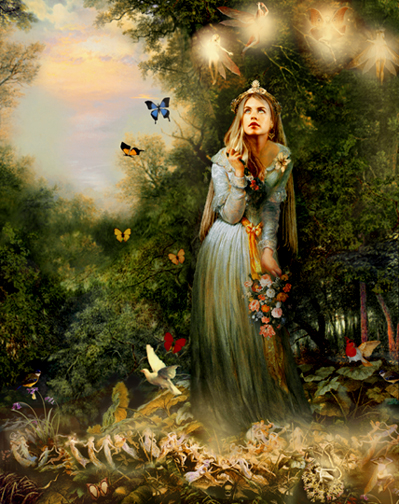
Trebaruna of the secret home is also associated with ravens and wolves. This has interesting correlations with Odin among other similar deities.

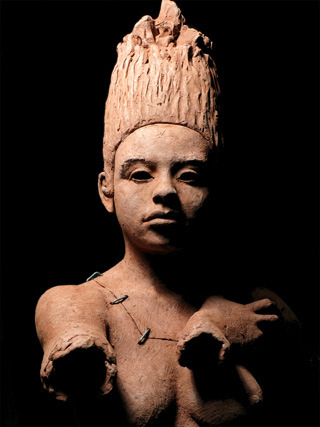
For this one we'll skim over Moonspell's works starting with Their first Album and we'll look at song names and see how they all connect.

If I'm a Steppenwolf than it's because I follow my

Under the "Lua d'Inverno" I hide in the "Wolfshade" "Of Dream and Drama" because I've committed "An Erotic Alchemy" of "Love Crimes" in the name of the "Alma Mater" that we can call "Ataegina" or "Trebaruna" who taught me the secrets of "Vampiria"...

Alma Mater
It means "Bountiful, Nourishing, Kind Mother".
Before its current usage, alma mater was an honorific title for various Latin mother goddesses, especially Ceres or Cybele,[3] and later in Catholicism for the Virgin Mary.
Although alma (nourishing) was a common epithet for Ceres, Cybele, Venus, and other mother goddesses, it was not frequently used in conjunction with mater in classical Latin.[6] In the Oxford Latin Dictionary, the phrase is attributed to Lucretius' De rerum natura, where it is used as an epithet to describe an earth goddess:
We are all sprung from that celestial seed,
all of us have same father, from whom earth,
the nourishing mother, receives drops of liquid moisture
After the fall of Rome, the term came into Christian liturgical usage in association with the Virgin Mary. "Alma Redemptoris Mater" is a well-known 11th century antiphon devoted to Mary.[6]
Ok but who is Ataegina or Trebaruna ??
Why, it's two faces of the Goddess that serves as the theme of this thread on Dreams!
Epigraphs from the Badajoz region associate the goddess with the Roman Proserpina or Persephone which would make her a goddess presiding over Spring and seasonality, echoing the "reborn" derivation of the name.
due to her mythical connections with Pluto (Proserpina was the wife of Pluto)
Atecina, Ataegina, Ategina, Adaecina, Adegina
And of course we have Pluto of the underworld, death, and the entity presiding over the Eternal Sleep and the Dreams of the Afterlife.
She is the "Reborn" as the Phoenix and is also closely associated with the Dawn of the new day (like Iris, Aurora, Eos, etc).

Trebaruna's cult was located in the cultural area of Gallaecia and Lusitania (in the territory of modern Galicia (Spain) and Portugal). Her name could be derived from the Celtic *trebo (home) and *runa (secret, mystery), suggesting a protector or protectress of property, home and families.
Trebaruna of the secret home is also associated with ravens and wolves. This has interesting correlations with Odin among other similar deities.


Ok now this really relates back to my other threads on the occult, so hopefully yall have read them.
We have Epona who is closely associated with Trebaruna and Ataegina, who even holds the cornucopia and is even equated with Cybele or Demeter - so therefore "Alma Mater".
So if you read that wiki, you'll see there are many connections and equations.
Rhiannon
Since I'm reflecting on the Celtic traditions, it's worth noting Ceridwen who is akin to Maya of illusions and enchantments;
Also recall that earlier in this thread we mentioned the symbolism of churning or stirring in a pot, which Ceridwen is often depicted doing.
She grants "Awen",
This all connects back into realizing one's Dreams by following Spirit and utilizing your natural talents.
Here's some Ataegina Epona poetry someone wrote.
Here's another one, which is a collection of a few sorrowful poems.

So Awen is also like Chi / Qi, the vital spark of life, the living principal.
It brings inspiration, creativity, wisdom.
Said to be the name the Universe calls itself inwardly - AWEN. (Flip the W and you get AMEN).
It is the Breath of God (Spirit) and so we can recall the earlier section on Ptah in this thread. It is often symbolized as 3 rays emanating from 3 dots (Truth, Balance, and Existence). It brings Knowledge, Prophecy, and Poetry (so therefore creative inspiration and artistic ability). These flow from Ceridwen's cauldron as she churns or stirs it. All language, symbolism, communication, creation, and divine mysticism come from AWEN.
It is the Tree of Life...

It is also the YinYang, the Triforce, the Triskelion, etc etc.

It can be depicted in all sorts of different ways... (Remember the AV motif as it will keep coming up in many ways).

Remember that a "W" is actually a double V "VV", so it is often pronounced as a V as well. So we have AVEN (as in an Ave Avian or Bird).
So let's go on some

and become

and heal ourselves with

We have Epona who is closely associated with Trebaruna and Ataegina, who even holds the cornucopia and is even equated with Cybele or Demeter - so therefore "Alma Mater".
She and her horses might also have been leaders of the soul in the after-life ride, with parallels in Rhiannon of the Mabinogion.[2] The worship of Epona, "the sole Celtic divinity ultimately worshipped in Rome itself",[3] was widespread in the Roman Empire between the first and third centuries AD; this is unusual for a Celtic deity, most of whom were associated with specific localities.
In an episode preserved in a remark of Pausanias,[6] an archaic Demeter Erinys (Vengeful Demeter) too had also been a Great Mare, who was mounted by Poseidon in the form of a stallion and foaled Arion and the Daughter who was unnamed outside the Arcadian mysteries.[7] Demeter was venerated as a mare in Lycosoura in Arcadia into historical times.
So if you read that wiki, you'll see there are many connections and equations.
Rhiannon
Since I'm reflecting on the Celtic traditions, it's worth noting Ceridwen who is akin to Maya of illusions and enchantments;
the Celtic goddess of rebirth, transformation, and inspiration.
Also recall that earlier in this thread we mentioned the symbolism of churning or stirring in a pot, which Ceridwen is often depicted doing.
She grants "Awen",
Awen is a Welsh, Cornish and Breton word for "(poetic) inspiration". In the Welsh tradition, awen is the inspiration of the poet bards; or, in its personification, Awen is the inspirational muse of creative artists in general: the inspired individual (often a poet or a soothsayer) is described as an awenydd. Emma Restall Orr, founder and former head of The Druid Network, defines awen as 'flowing spirit' and says that 'Spirit energy in flow is the essence of life'.
This all connects back into realizing one's Dreams by following Spirit and utilizing your natural talents.
Here's some Ataegina Epona poetry someone wrote.
Here's another one, which is a collection of a few sorrowful poems.

So Awen is also like Chi / Qi, the vital spark of life, the living principal.
It brings inspiration, creativity, wisdom.
Said to be the name the Universe calls itself inwardly - AWEN. (Flip the W and you get AMEN).
It is the Breath of God (Spirit) and so we can recall the earlier section on Ptah in this thread. It is often symbolized as 3 rays emanating from 3 dots (Truth, Balance, and Existence). It brings Knowledge, Prophecy, and Poetry (so therefore creative inspiration and artistic ability). These flow from Ceridwen's cauldron as she churns or stirs it. All language, symbolism, communication, creation, and divine mysticism come from AWEN.
It is the Tree of Life...

It is also the YinYang, the Triforce, the Triskelion, etc etc.

It can be depicted in all sorts of different ways... (Remember the AV motif as it will keep coming up in many ways).

Remember that a "W" is actually a double V "VV", so it is often pronounced as a V as well. So we have AVEN (as in an Ave Avian or Bird).
So let's go on some

and become

and heal ourselves with

And check this out:
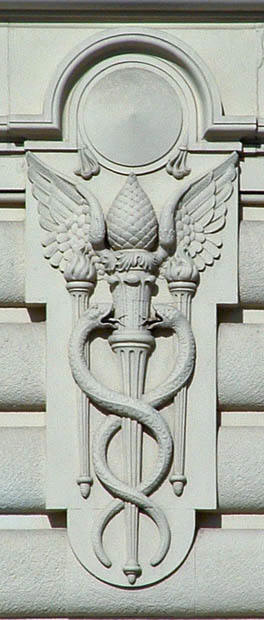
The 3 torches are the Awen of Amen.
Nailed it!

The 3 torches are the Awen of Amen.
Nailed it!
Here I'll explain again real quick how this works:

That is the triple Goddess of a thousand hands in China, from 1 is 2 is 3 is thousands.
All emanates from 1.
So this will be like the 2nd or 3rd time in this thread I've brought up Guishan Guanyin of the Thousand Hands and Eyes

This is a key to understanding exactly why the Peacock was used so heavily in the iconography and symbolism.
So we can have all sorts of motifs blended into 1, from the provider, the dawn and rebirth, the underworld and death, to communication and traveling.
So that's why the above deity Epona can be equated with Mercury or Iris, because that is a large part of what the White Horse mythology is all about.
How does it connect? Cmon, Guanyin is also spelled Gwan, as Cerridwen is also CerriGwen.
This is not a coincidence though the way it connects is amazing. Remember that Gwen means "Fair, White"? It also can mean Spirit in these contexts.
Guanyin can also mean "Observer" - "Conceptualizes", or an older version of the name, Xuanzang, means "Self-Conceiving".
觀自在 = "Concept From Oneself" or "Becoming"
The last symbol zài 在 is "Dwell, Exist, Be, Be Alive, Belong, Depend, In, At".
Further research may be done at this wiki: Avalokitesvara

That is the triple Goddess of a thousand hands in China, from 1 is 2 is 3 is thousands.
All emanates from 1.
So this will be like the 2nd or 3rd time in this thread I've brought up Guishan Guanyin of the Thousand Hands and Eyes

This is a key to understanding exactly why the Peacock was used so heavily in the iconography and symbolism.
So we can have all sorts of motifs blended into 1, from the provider, the dawn and rebirth, the underworld and death, to communication and traveling.
So that's why the above deity Epona can be equated with Mercury or Iris, because that is a large part of what the White Horse mythology is all about.
White horses have a special significance in the mythologies of cultures around the world. They are often associated with the sun chariot,[1] with warrior-heroes, with fertility (in both mare and stallion manifestations), or with an end-of-time saviour, but other interpretations exist as well. Both truly white horses and the more common grey horses, with completely white hair coats, were identified as "white" by various religious and cultural traditions.
How does it connect? Cmon, Guanyin is also spelled Gwan, as Cerridwen is also CerriGwen.
This is not a coincidence though the way it connects is amazing. Remember that Gwen means "Fair, White"? It also can mean Spirit in these contexts.
Guanyin can also mean "Observer" - "Conceptualizes", or an older version of the name, Xuanzang, means "Self-Conceiving".
觀自在 = "Concept From Oneself" or "Becoming"
The last symbol zài 在 is "Dwell, Exist, Be, Be Alive, Belong, Depend, In, At".
Further research may be done at this wiki: Avalokitesvara
edit on 6/4/2018 by muzzleflash because: (no reason given)
edit on 6/4/2018 by muzzleflash because: (no reason given)
I too am "Irreligious" with the "Full Moon Madness", and when I write a thread about "Opium" it's "Perverse...Almost Religious". Most think it's
"Subversion" because with "Raven Claws" I offer "A Poisoned Gift" of "Ruin and Misery" and "Selfabuse", it's my "Soulitary Vice".
I tell the tale of "Darkness and Hope", of "Firewalking" in the "Heartshaped Abyss" "For a Taste of Eternity" so that I may finally "Mute" my "Flesh", find my "2econd Skin" and finally be "Awake!" like "The Hanged Man".
I've been "Tired" and "Soulsick" because I'm the "Devilred" "Angelizer" singing a "Ghostsong" in this "Opera Carne" for my "Magdalene", maybe it's a "Dekadance" in "Eurotica"?
I wish I could "Disappear Here" in "Nocturna", but it "Can't Bee" for "I Am the Eternal Spectator" who sees in "Butterfly FX" "At Tragic Heights" under the "Shadow Sun" while the "Scorpion Flower" is in "Funeral Bloom".
"The Future Is Dark" but "The Last of Us" will not go "Extinct" taking "A Walk on the Darkside" "As We Eternally Sleep on It" with "Domina" "Medusalem" "La Baphomette", because at "First Light" you'll find the "Antidote" "In and Above Men" "From Lowering Skies" while "Crystal Gazing" "At the Image of Pain".
I'll tell you "How We Became Fire", we were "Made of Storm" "Em Nome do Medo" on "New Tears Eve" when the "Sons of Earth" said "Love Is Blasphemy" in their "Sacrificial" "Proliferation". But I'm here to tell you that's "Best Forgotten" because they're "A Dying Breed", "Dreamless" with their "handmadeGod" named "Mr. Crowley", but he's no more real "Than the Serpents in my Arms".
I hear what "Blood Tells" to the deaf, it is "Memento Mori" "In Memoriam" of "A Greater Darkness" and that we must "Slow Down!" and "Breathe (Until We Are No More)".
You see, I "Grandstand" in the "Sanguine" "Fireseason" because "Luna" up in the "White Skies" is my "Herodisiac", the "Versus" of "Alpha Noir/Omega White", and "Hers Is the Twilight" though "Once It Was Ours!"
I tell the tale of "Darkness and Hope", of "Firewalking" in the "Heartshaped Abyss" "For a Taste of Eternity" so that I may finally "Mute" my "Flesh", find my "2econd Skin" and finally be "Awake!" like "The Hanged Man".
I've been "Tired" and "Soulsick" because I'm the "Devilred" "Angelizer" singing a "Ghostsong" in this "Opera Carne" for my "Magdalene", maybe it's a "Dekadance" in "Eurotica"?
I wish I could "Disappear Here" in "Nocturna", but it "Can't Bee" for "I Am the Eternal Spectator" who sees in "Butterfly FX" "At Tragic Heights" under the "Shadow Sun" while the "Scorpion Flower" is in "Funeral Bloom".
"The Future Is Dark" but "The Last of Us" will not go "Extinct" taking "A Walk on the Darkside" "As We Eternally Sleep on It" with "Domina" "Medusalem" "La Baphomette", because at "First Light" you'll find the "Antidote" "In and Above Men" "From Lowering Skies" while "Crystal Gazing" "At the Image of Pain".
I'll tell you "How We Became Fire", we were "Made of Storm" "Em Nome do Medo" on "New Tears Eve" when the "Sons of Earth" said "Love Is Blasphemy" in their "Sacrificial" "Proliferation". But I'm here to tell you that's "Best Forgotten" because they're "A Dying Breed", "Dreamless" with their "handmadeGod" named "Mr. Crowley", but he's no more real "Than the Serpents in my Arms".
I hear what "Blood Tells" to the deaf, it is "Memento Mori" "In Memoriam" of "A Greater Darkness" and that we must "Slow Down!" and "Breathe (Until We Are No More)".
You see, I "Grandstand" in the "Sanguine" "Fireseason" because "Luna" up in the "White Skies" is my "Herodisiac", the "Versus" of "Alpha Noir/Omega White", and "Hers Is the Twilight" though "Once It Was Ours!"
Hmmm, In Memoriam A.H.H.
This Requiem came up, which is actually very fitting. Tennyson wrote some of our most popular phrases that we still use today.

Nothing truer has ever been said.
What is life about anyways?




"In Memoriam A.H.H." or simply "In Memoriam" is a poem by the British poet Alfred, Lord Tennyson, completed in 1849.
It contains some of Tennyson's most accomplished lyrical work, and is an unusually sustained exercise in lyric verse. It is widely considered to be one of the great poems of the 19th century.[1]
The original title of the poem was "The Way of the Soul", and this might give an idea of how the poem is an account of all Tennyson's thoughts and emotions as he grieves over the death of a close friend.
He views the cruelty of nature and mortality in light of materialist science and faith. Owing to its length and its arguable breadth of focus, the poem might not be thought an elegy or a dirge in the strictest formal sense.
This Requiem came up, which is actually very fitting. Tennyson wrote some of our most popular phrases that we still use today.

Nothing truer has ever been said.
What is life about anyways?




As a human being, you cannot eliminate or avoid your nature - you must embrace and conquer it...




So I was reading this (very high quality excellent) comic about a month ago (of one of my favorite fictional characters), and I thought this title is
a perfect addition to this section:



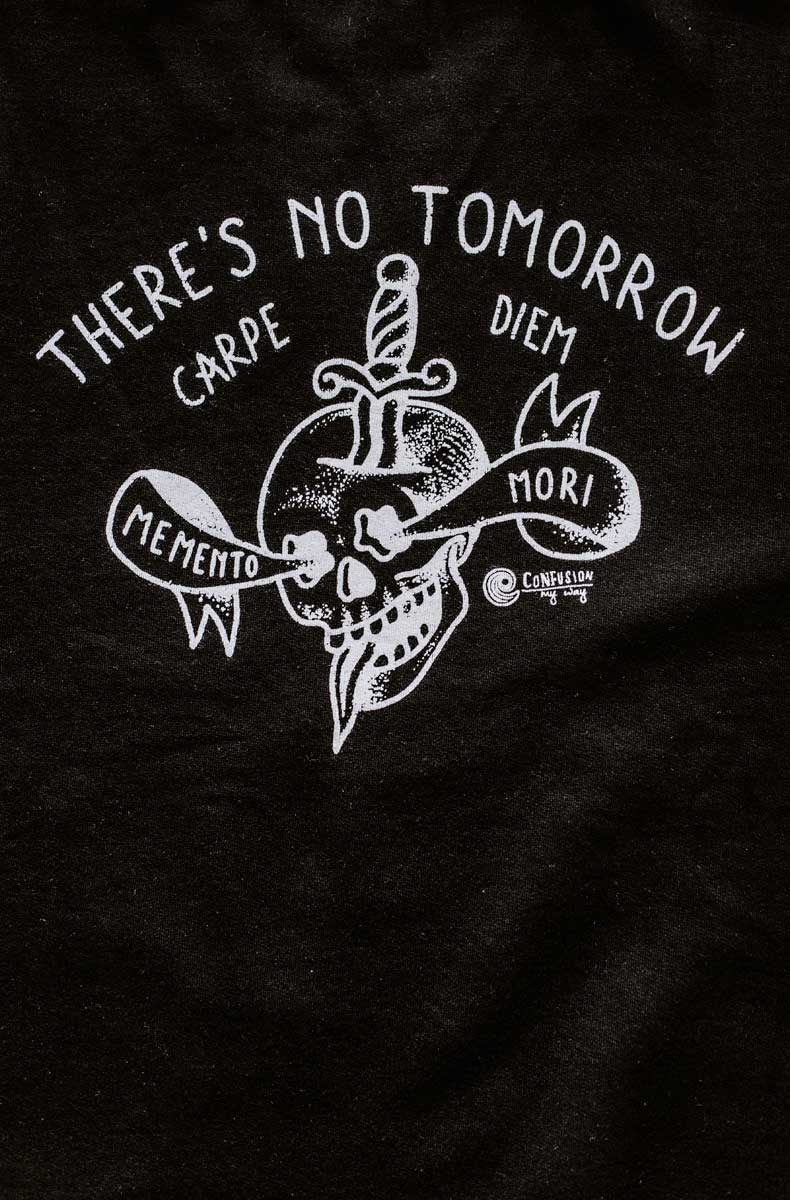






Memento Mori
Remember! You Die!
Seize Today, YOLO, Time Flies, and


Memento mori (Latin: "remember that you have to die")[2] is the medieval Latin Christiantheory and practice of reflection on mortality, especially as a means of considering the vanity of earthly life and the transient nature of all earthly goods and pursuits.
It is related to the ars moriendi ("The Art of Dying") and similar literature. Memento mori has been an important part of ascetic disciplines as a means of perfecting the character by cultivating detachment and other virtues, and by turning the attention towards the immortality of the soul and the afterlife.[3]
In art, memento mori are artistic or symbolic reminders of mortality.[2] In the European Christian art context, "the expression [...] developed with the growth of Christianity, which emphasized Heaven, Hell, and salvationof the soul in the afterlife".[4]
Remember! You Die!
Seize Today, YOLO, Time Flies, and

Plato's Phaedo, where the death of Socrates is recounted, introduces the idea that the proper practice of philosophy is "about nothing else but dying and being dead".[7]
The Stoics were particularly prominent in their use of this discipline, and Seneca's letters are full of injunctions to meditate on death.[8]
The Stoic Epictetus told his students that when kissing their child, brother, or friend, they should remind themselves that they are mortal, curbing their pleasure, as do "those who stand behind men in their triumphs and remind them that they are mortal"[9]

The thought was then utilized in Christianity, whose strong emphasis on divine judgment, Heaven, Hell, and the Salvation of the soul brought death to the forefront of consciousness.[11]
To the Christian, the prospect of death serves to emphasize the emptiness and fleetingness of earthly pleasures, luxuries, and achievements, and thus also as an invitation to focus one's thoughts on the prospect of the afterlife.
Ecclesiasticus (Sirach) 7:40, "in all thy works be mindful of thy last end and thou wilt never sin."
This finds ritual expression in the rites of Ash Wednesday, when ashes are placed upon the worshipers' heads with the words, "Remember Man that you are dust and unto dust you shall return."


You ever wonder why Peacocks take "Dust baths"? A lot of people wonder why, it seems like such an odd behavior for a bird, even scientists have been studying it...

The most obvious places to look for memento mori meditations are in funeral art and architecture. Perhaps the most striking to contemporary minds is the transi, or cadaver tomb, a tomb that depicts the decayed corpseof the deceased. This became a fashion in the tombs of the wealthy in the fifteenth century, and surviving examples still create a stark reminder of the vanity of earthly riches.
People care about money so much, they rarely have time to enjoy their life! Bird behavior is easier to understand, yet we think they are the inferior intellects...
Well, I'd rather live like Odin and be a one-eyed bird brain if it's all the same.

These skulls are called Memento Mori, obviously. And I don't scry with a crystal ball, I use my skull to see that my life's full.


And that's cuz...



In this house of dreams and smokey mirrors there are many curiosities, like this memento mori shadow box of a peacock swallowtail butterfly...

And other bizarre works of art...

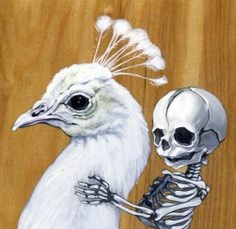
Death rides on your Dreams, and Dances on your Dust.
The danse macabre is another well-known example of the memento mori theme, with its dancing depiction of the Grim Reaper carrying off rich and poor alike. This and similar depictions of Death decorated many European churches.
Time Flies I heard, and Flees like a Bird!!
Timepieces were formerly an apt reminder that your time on Earth grows shorter with each passing minute. Public clocks would be decorated with mottos such as ultima forsan("perhaps the last" [hour]) or vulnerant omnes, ultima necat ("they all wound, and the last kills"). Even today, clocks often carry the motto tempus fugit, "time flees"

The PeaClock is tickin!
A version of the theme in the artistic genre of still life is more often referred to as a vanitas, Latin for "vanity". These include symbols of mortality, whether obvious ones such as skulls or more subtle ones such as a flower losing its petals.
The Vain wane as the Reaper waxes the floors in Valhalla. Or something like that.
So whatcha gonna do about it? I know what I'm doin...




I'm building a Temple in my Heart...


Maybe life's been a disaster - but we ain't dead yet.
It's Time...

Life can be so Brutal... and it can be so Beautiful.
It's up to you whatcha gonna do.

If you're gonna Burn - do it right - engulf the night in your Light!




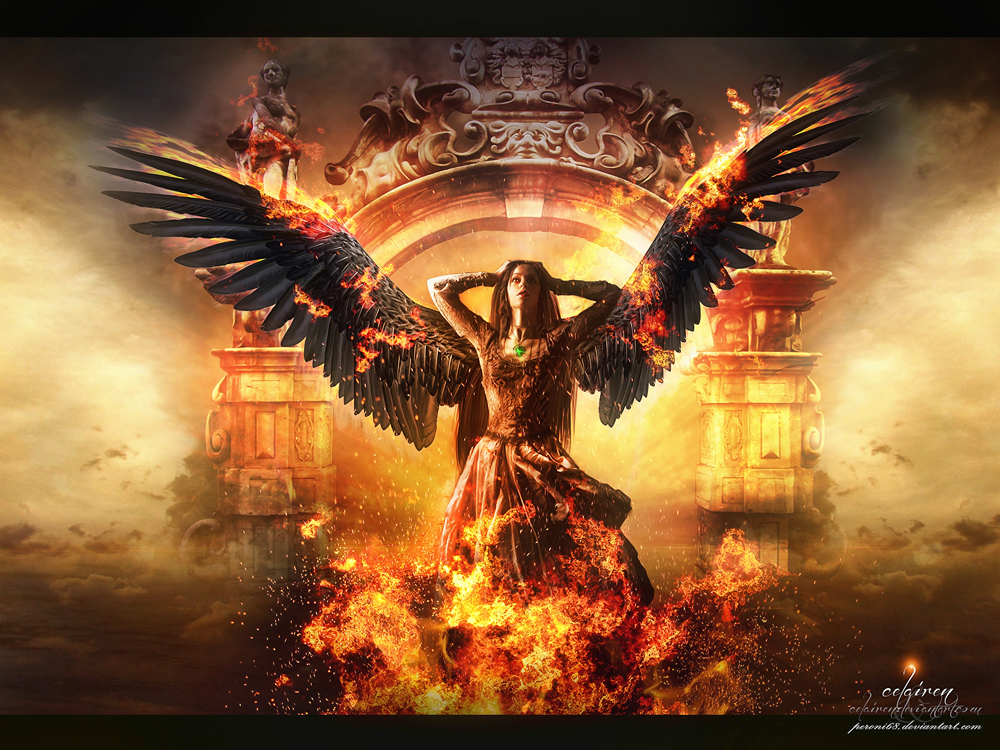
It's Time...

Life can be so Brutal... and it can be so Beautiful.
It's up to you whatcha gonna do.

If you're gonna Burn - do it right - engulf the night in your Light!





Memento mori was the salutation used by the Hermits of St. Paul of France (1620-1633), also known as the Brothers of Death.

Why why should I the World be minding, Therein a World of Evils Finding. Then Farwell World: Farwell thy jarres, thy Joies thy Toies thy Wiles thy Warrs. Truth Sounds Retreat: I am not sorye. The Eternall Drawes to him my heart, By Faith (which can thy Force Subvert) To Crowne me (after Grace) with Glory.
- Thomas Smith

Another manifestation of memento mori is found in the Mexican "Calavera", a literary composition in verse form normally written in honour of a person who is still alive, but written as if that person were dead. These compositions have a comedic tone and are often offered from one friend to another during Day of the Dead.


new topics
-
New job to help stop school shootings
Social Issues and Civil Unrest: 5 hours ago
top topics
-
Political Warfare & The Resister Special Forces Underground
Political Ideology: 15 hours ago, 9 flags -
Covid Jab and the Alien Invasion
ATS Skunk Works: 12 hours ago, 9 flags -
Trump Cancel trip to New Jersey because of drones
Aliens and UFOs: 15 hours ago, 8 flags -
New job to help stop school shootings
Social Issues and Civil Unrest: 5 hours ago, 3 flags -
Quantum Computer’s, Plasmoid’s, & UAP’s
Aliens and UFOs: 12 hours ago, 2 flags
active topics
-
Quantum Computer’s, Plasmoid’s, & UAP’s
Aliens and UFOs • 12 • : BeyondKnowledge3 -
New job to help stop school shootings
Social Issues and Civil Unrest • 14 • : Shoshanna -
Covid Jab and the Alien Invasion
ATS Skunk Works • 15 • : asabuvsobelow -
Statements of Intent from Incoming Trump Administration Members - 2025 to 2029.
2024 Elections • 47 • : WeMustCare -
Remember These Attacks When President Trump 2.0 Retribution-Justice Commences.
2024 Elections • 108 • : xuenchen -
School shooting in Madison Wi.
Social Issues and Civil Unrest • 50 • : hangedman13 -
The Acronym Game .. Pt.4
General Chit Chat • 1021 • : JJproductions -
-@TH3WH17ERABB17- -Q- ---TIME TO SHOW THE WORLD--- -Part- --44--
Dissecting Disinformation • 3736 • : WeMustCare -
The Fight for Election Integrity Continues -- Audits, Criminal Investigations, Legislative Reform
2024 Elections • 4368 • : Kaiju666 -
Mood Music Part VI
Music • 3737 • : underpass61







